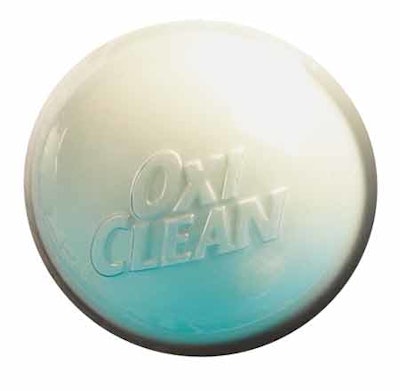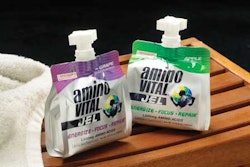A solid ball of detergent, Oxi Clean “Toss-n-Go” is no ordinary laundry product. Its packaging, a thermoformed clamshell inside a conical paperboard sleeve, is equally innovative. Amid the ever-so-predictable jugs and boxes in the detergent section of the aisle, the conical sleeve package with the protruding ball in the front really stands out.
Making all of this even more unusual is that the detergent is filled as a slurry directly into the clamshell during manufacturing before it cools and hardens. Thermoformed of 18-ga polyvinyl chloride, the clamshell functions both as mold and as container.
But wait, there's more, as company pitchman Billy Mays would say. In the starter kit, there's an entirely different ball, made of blue rubber, at the bottom of the sleeve cone. It's a dispensing ball that's injection molded using a thermoplastic elastomer, or TPE. It holds the detergent ball during use when it's tossed into the laundry. It controls the dissolution of the laundry ball as well as protecting the washer drum from damage. Consumers close the blue ball's sealing flap to lock in the detergent ball during use. That required engineering and polymer chemistry expertise.
The consumer removes the detergent ball from the clamshell and places it into the rubber ball and leaves it in the wash for 25 loads. No more measuring and pouring of detergent. “It's all about convenience,” says Jon-Paul Genest, director of engineering and manufacturing for C&D's Orange Glo division.
This new concept laundry detergent was launched mid-summer in starter kit and refill kit that retail for about $6.99 and $9.99, respectively.
The entire “Toss-n-Go” package and all components are a well-engineered meeting of form and function. With the exception of the blue ball, the package components are produced by Display Pack (www.displaypack.com) and distributed through M. Jacob and Sons (www.mjacobandsons.com).
The project got rolling in 2005 when Orange Glo Intl., Littleton, CO, now part of Church & Dwight, Princeton, NJ, contacted Display Pack about a clamshell package that would function as the spherical “form” for the end product as well as function as the package. After much testing, the end result was the PVC clamshell, which was absolutely crucial to the product.
Challenging clamshell
Here's what Packaging World has been able to learn about the package so far. The clamshell's tab-based, friction-fit closure in the seal area was key to the development: The seal had to be weak to accommodate the expansion of the product as it cooled, yet also strong enough so that the clamshell was effectively sealed afterwards. The seal actually gets stronger as the product cools and expands, but is also designed not to be too strong so as to be an opening problem for consumers, according to Genest. The package development team working with Display Pack found an elegant and functional design with the proper gauge of material that was a complex, but happy balance to solving the stress challenge.
“You'd never go to a package vendor and instruct them to make the seal weak,” notes Genest in describing the clamshell's unique requirements. “We created seal tolerances unusual for a clamshell.”
For that reason, it also couldn't be a hermetic package, even apart from the product fill hole on the backside of the clamshell's lid. The clamshell had to be engineered with just the right amount of “give.”
It's pretty remarkable, considering all the interrelated complexities, that the package development team only went through a half-dozen iterations to get it just right.
Although the clamshell is made of PVC, other materials were tested, including high-density polyethylene and recycled PET. Industry sources indicated that PVC was flexible enough to withstand the product expansion and subsequent stress, and its success in initial tests positioned it better for the fast-track launch timeframe. However, RPET also worked well, and it is being considered in the future to make the packaging more environmentally friendly.
In-line filling, then cured
The product is contract packaged by Apco Packaging (www.apcopackaging.com) on multiple custom lines using a single-headed filler at a rate around 18 clamshells/line/min. The detergent slurry, which is about the consistency of pancake batter, is filled at room temperature directly into the clamshell in a continuous process, Genest says. After that, the detergent ball hardens during what is actually a complex exothermic chemical reaction—the product temperature increases some 30º—during which the filled clamshells are kept in a temperature-controlled room. This was among the unusual and complex technical challenges solved by the development team.
Conical sleeve
Developing the brightly decorated paperboard sleeve was a no piece of cake, either. The conical sleeve met several requirements, too. For one thing, the conical design differentiates the product among detergent jugs and boxes in a very competitive category. The package provides a large promotional billboard to stand out as well as hold the components. The sleeve is made out of .020 SBS paperboard offset-printed and UV coated at Display Pack.
As with all cones, the bottom is wider than the top, which provides a nice loading “tube” for the contents of clamshells and/or rubber ball to be inserted and secured. The contents are loaded manually through the bottom.
Tabs on the clamshell side correspond to cutouts on the back top of the outer sleeve that permit it to be locked and suspended at the top of the sleeve. Lastly after the package contents are added, an end cap, thermoformed of 20-ga PVC, is inserted into the (wider) base of the cone sleeve. It is affixed in place to the sleeve walls by staples, which were chosen over hot-melt adhesive as a stronger choice, Genest says.
The staples and end cap prevent pilferage of the contents and help the paperboard sleeve support the weight of the one or two detergent balls, weighing nearly 15-oz each. The clear end cap also offers visual inspection of the contents by consumers who want to see more.
The sleeve cutouts permit consumers to see what the product and its components are all about. Besides the main ball cutout in the package front, cutouts in the backside of the starter kit's sleeve permit consumers to see and feel the blue dispenser ball. It helps convince consumers that it is made of soft rubber and safe for them to put into their laundry, Genest explains.
The sleeve's tearstrip opening on the back permits consumer to open the package without destroying it so that the use instructions remain intact and readable.
The product concept also provides an environmentally friendly angle through source reduction. Compared with the equivalent amount of bottled liquid detergent, it's claimed that the Toss-n-Go product reduces the amount of packaging by weight by 60 to 70%.
“A 100-oz bottle of Tide detergent contains 128 grams of plastic, while our packaging amounts to less than 30 grams,” says Genest.
Consumer reaction in test was high, according to Church & Dwight, and was expected to correspond to an immediate and enthusiastic market reception.


























